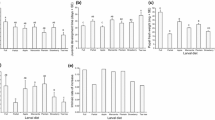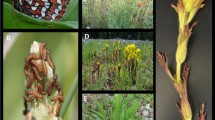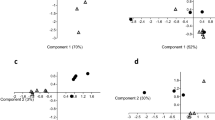Summary
The impact of differences in host plants on individuals and populations of insect herbivores was investigated using the milkweed longhorn beetle, Tetraopes tetrophthalmus (Forster), larvae of which feed parasitically on host rhizomes. One host, Asclepias syriaca L., was larger in stem and rhizome diameter and grew in cooler soil than the other host, A. verticillata L. The major effects on beetles were retarded phenology at the cooler site and reduced size on the smaller host. Reduced size of beetles was correlated with several important individual attributes: reduced length of life, number of ovarioles, egg size, and a reduced probability of mating with large beetles. The population consequences of these characteristics, largely inferred from these observations, were little or no outbreeding in the small population on A. verticillata.
Similar content being viewed by others
References
Bush, G.L.: The mechanism of sympatric host race formation in the true fruit flies (Tephritidae), pp. 3–23. In: Genetic mechanisms of speciation in insects (M.J.D. White, ed.). Sydney: Aust. and New Zealand Book 1974
Bush, G.L.: Sympatric speciation in phytophagous parasitic insects, pp. 187–206. In: Evolutionary strategies of parasitic insects and mites (P.W. Price, ed.). New York: Plenum 1975
Chemsak, J.A.: Taxonomy and bionomics of the genus Tetraopes (Cerambycidae: Coleoptera). Univ. California Pub. Entomol. 30, 1–90 (1963)
Cruden, R.W.: Pollination biology of Nemophila menziesii (Hydrophyllaceae) with comments on the evolution of oligolectic bees. Evolution 26, 373–389 (1972)
Ehrlich, P.R., Raven, P.H.: Butterflies and plants: A study in coevolution. Evolution 18, 586–608 (1964)
Hespenheide, H.A.: Ecological inferences from morphological data. Annu. Rev. Ecol. Syst. 4, 213–229 (1973)
Jones, G.H.: Flora of Illinois. Amer. Midl. Natur. Monogr. 7, 401 pp. (1963)
Linsley, E.G., MacSwain, J.W.: The significance of floral constancy among bees of the genus Diadasia. Evolution 12, 219–223 (1958)
Mason, L.G.: Geographic and temporal variation in natural populations of Tetraopes tetraophthalmus. Syst. Zool. 13, 161–181 (1964)
Pilat, T.J.: Reproductive behavior in two species of Tetraopes (Coleoptera, Cerambycidae). Proc. Peoria Acad. Sci 8, 16–25 (1975)
Price, P.W.: Reproductive strategies of parasitoids, pp. 87–111. In: Evolutionary strategies of parasitic insects and mites (P.W. Price, ed.). New York: Plenum 1975
Southwood, T.R.E.: Ecological methods, with particular reference to the study of insect populations, 391 pp. London: Methuen 1966
Thorp, R.W.: Systematics and ecology of bees of the subgenus Diandrena (Hymenoptera: Andrenidae). Univ. California Pub. Entomol. 52, 1–146 (1969)
Author information
Authors and Affiliations
Rights and permissions
About this article
Cite this article
Price, P.W., Willson, M.F. Some consequences for a parasitic herbivore, the milkweed longhorn beetle, Tetraopes tetrophthalmus, of a host-plant shift from Asdepias syriaca to A. verticillata . Oecologia 25, 331–340 (1976). https://doi.org/10.1007/BF00345606
Received:
Issue Date:
DOI: https://doi.org/10.1007/BF00345606




